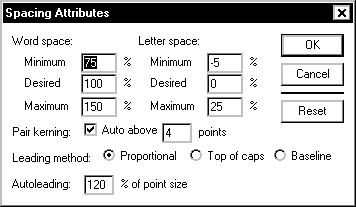Adobe PageMaker 7.0 – Advanced Character Formatting
Advanced Character Formatting
Tracking, kerning, and spacing allows you to control the space between characters. Tracking is useful for adjusting the spacing in larger blocks of text, whereas kerning is helpful for fine-tuning the space between individual characters. By adjusting the tracking first, you may have to do less kerning. Spacing allows you to adjust the space between individual characters, words, and lines.
 Working with Tracking
Working with Tracking
Tracking adjusts the relative space between letters and words so that they are spaced more closely together at a tight track setting or further apart at a loose track setting. Tracking can be helpful for darkening or lightening a page (type with tight tracking darkens the page while type with loose tracking lightens a page) or for changing the spacing of selected lines of very large or very small type, such as headlines and captions. Track settings can also be used to make text fit in a defined space on a page.
PageMaker offers several tracking options from Very Loose to Very Tight. You can adjust the track for an entire paragraph, a single line, or a few characters. Here is an example of the different types of tracking as opposed to normal text:
Applying Tracking: Menu Option
-
Select the text that you want to track
-
From the Type menu, select Expert Tracking » select the desired degree of tracking
Returning to the normal track:
-
Select the text that you want to track
-
From the Type menu, select Expert Tracking » Normal
Applying Tracking: Control Palette
-
Select the text that you want to track
-
On the Control Palette, from the Tracking pull-down list, select the desired choice

 Working with Kerning
Working with Kerning
Kerning refers to the spacing between pairs of characters. Most characters have been kerned already through automatic pair kerning for the most optimal effect. For example, a typeface may have built-in pair kerning for the characters T and o, so that the o is tucked under the top of the T. However, since automatic pair kerning rarely covers every character pair combination, manual kerning may be necessary.
PageMaker allows you to kern text automatically or manually between two characters or, if necessary, over a range of text. Here is an example of what kerned characters look like as opposed to regular characters:
Setting Automatic Kerning
-
Select the text you want to kern
NOTE: Kerning affects the space after a character. If you want to change only the kerning of a word, but not the width of space after the word, select all but the last character of the word. -
From the Type menu, select Paragraph…
OR
Press [Ctrl] + [M]
The Paragraph Specifications dialog box appears. -
From the Paragraph Specifications dialog box, click SPACING…
The Spacing Attributes dialog box appears.
-
For Pair Kerning, select Auto Above
The selection should now be checked. -
In the Auto above text box, type the font point size above which you want to apply auto-kerning
Pair kerning will automatically apply to font sizes greater than this value. -
To return to the Paragraph Specifications dialog box, click OK
-
To return to your document, click OK
Manual Kerning with the Control Palette
-
Place your insertion point between the two characters you want to kern
OR
Select the text you want to kern
NOTE: Kerning affects the space after a character. If you want to change the kerning of a word, but not the width of space after the word, select all but the last character of the word. -
To add space between characters from the Control Palette, click RIGHT NUDGE

To delete space between characters from the Control Palette, click LEFT NUDGE

 Working With Spacing
Working With Spacing
Spacing refers to the space between individual letters or words. Letter spacing is designed to include both the width of the character and the amount of space surrounding it. Although typefaces are designed with the optimal amount of spacing, certain situations can result in the type looking either too cramped or too loose. Adjusting the spacing between characters and words can improve legibility.
Each font is also designed with its own spaceband, which is the space between words created by pressing the spacebar. By default, word spacing in PageMaker uses 100% of the spaceband. You can adjust the percentage of spacing between words from 0% to 500%. Letter spacing values range from -200% to 200%.
Adjusting Spacing
-
Select the text that needs the spacing adjusted
-
From the Type menu, select Paragraph…
OR
Press [Ctrl] + [M]
The Paragraph Specifications dialog box appears. -
From the Paragraph Specifications dialog box, click SPACING…
The Spacing Attributes dialog box appears.
-
In the Word space text boxes, type the desired values
NOTE: If you are working with only justified type, adjust the word space using the Minimum and Maximum values only. To specify word space for both justified and unjustified test, use Desired. -
In the Letter space text boxes, type the desired values
NOTE: If you are working with only justified type, adjust the word space using the Minimum and Maximum values only. To specify word space for both justified and unjustified test, use Desired. -
Click OK
-
In the Paragraph Specifications dialog box, click OK


Comments